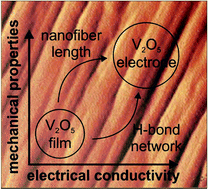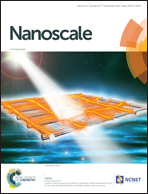Free-standing nanostructured vanadium pentoxide films for metal-ion batteries†
Abstract
Owing to their unique layer structure, high aspect ratio and intercalation capability, vanadium pentoxide (V2O5) nanofibers are close-to-ideal building blocks for high performance electrodes for metal-ion batteries. However, thus far investigated electrodes composed of V2O5 nanofibers mostly contain binders and conductive agents, which reduce the electrodes’ gravimetric capacity. Here we demonstrate self-supporting V2O5 nanofiber-based films that combine high mechanical flexibility and stability with good electrical conductivity. This has been achieved by suitable adjustment of the nanofiber length, in combination with a suitable humidity controlled post-treatment, to ensure an effective nanofiber interconnection and aging of the films. The optimization of these two parameters allows for an impressive 81%, 184%, and 281% enhancement in Young's modulus, tensile strength and toughness respectively, along with an increase of electrical conductivity by up to 165%. Such films can reach storage capacities of up to 150 mA h g−1 without the support of conductive agents and binders. Our findings provide fundamental design guidelines for advanced binder-free electrode materials, which unite high specific storage capacity, excellent mechanical stability and good intrinsic electrical conductivity – the key to technologically advanced battery performance and lifetime.



 Please wait while we load your content...
Please wait while we load your content...